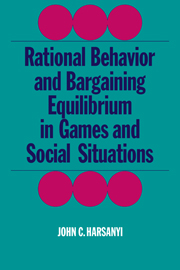Book contents
- Frontmatter
- Contents
- Preface
- Part 1 Preliminaries
- Part II General principles
- Part III Solutions for specific classes of games
- 8 Two-person simple bargaining games: the Nash solution
- 9 General two-person cooperative games
- 10 n-Person simple bargaining games
- 11 n-Person cooperative games with transferable utility: the modified Shapley value
- 12 n-Person cooperative games: the general case
- 13 n-Person cooperative games: discriminatory solutions
- 14 Noncooperative and almost-noncooperative games
- 15 Conclusion
- Notes
- References
- Index
8 - Two-person simple bargaining games: the Nash solution
Published online by Cambridge University Press: 24 November 2009
- Frontmatter
- Contents
- Preface
- Part 1 Preliminaries
- Part II General principles
- Part III Solutions for specific classes of games
- 8 Two-person simple bargaining games: the Nash solution
- 9 General two-person cooperative games
- 10 n-Person simple bargaining games
- 11 n-Person cooperative games with transferable utility: the modified Shapley value
- 12 n-Person cooperative games: the general case
- 13 n-Person cooperative games: discriminatory solutions
- 14 Noncooperative and almost-noncooperative games
- 15 Conclusion
- Notes
- References
- Index
Summary
Definitions and assumptions
We will first consider only vocal cooperative games. We make the following assumptions. The two players can achieve any payoff vector u = (u1, u2) within the payoff space P of the game, if they can agree which particular payoff vector u to adopt, i.e., if they can agree how to divide the payoffs between them. The players are free to use jointly randomized mixed strategies, which make the payoff space P a convex set. Moreover,P is assumed to be bounded and closed, i.e., compact. We also exclude the degenerate case in which the payoff space is a segment of a straight line with ui = const. for either player i: Any such case will always have to be treated as a strictly noncooperative game, since player i would have no incentive whatever to cooperate with the other player.
Among cooperative games we will distinguish two cases, depending on the nature of the conflict situation that would emerge if the two players could not agree on their final payoffs u1 = ū1 and u2 = ū2. In a simple bargaining game the rules of the game themselves fully specify the conflict-payoff vector or conflict point c = (c1, c2) to which the players would be confined in such a conflict situation. This means that the players have essentially only one conflict strategy, viz., simple noncooperation.
- Type
- Chapter
- Information
- Publisher: Cambridge University PressPrint publication year: 1977



